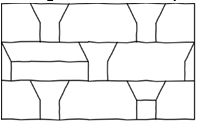This set of Basic Civil Engineering Multiple Choice Questions & Answers (MCQs) focuses on “Stone Masonry”.
1. Which stone is used for buildings situated in industrial towns?
a) Marble slab
b) Compact sandstone
c) Gneiss
d) Slate
View Answer
Explanation: Granite and compact sandstone are generally used for buildings situated in
industrial towns. Marble slab and slate are used for electrical switch boards and gneiss is used for heavy engineering works.
2. Rubble masonry is sub-divided into:
a) 4
b) 2
c) 6
d) 10
View Answer
Explanation: Rubble masonry uses stones of irregular size. The sub groups are coursed, uncoursed, random rubble, dry rubble, polygonal and flint rubble.
3. The figure below represents:

a) Coursed rubble masonry I
b) Coursed rubble masonry II
c) Coursed rubble masonry III
d) Coursed rubble masonry IV
View Answer
Explanation: In type I, stones of the same height are to be used and courses are of the same height. In type III, stones are to be of different height, course height need not be equal. In type II, as the figure indicates, stones are of different height, course is of equal height.
4. In random rubble masonry sort I, face stones are:
a) Chisel dressed
b) Hammer dressed
c) Axe dressed
d) Plain dressed
View Answer
Explanation: In random rubble masonry sort I, face stones are chisel dressed and thickness of mortar joints does not exceed 6mm.
5. Flints used in flint rubble masonry are:
a) Nodules of fly ash
b) Nodules of feldspar
c) Nodules of mica
d) Nodules of silica
View Answer
Explanation: Flints are irregularly shaped nodules of silica. The width and thickness varies from 80-15cm and length from 15-30cm.
6. Which of the below joints is used for masonry in arches?
a) Butt
b) Table
c) Rebated
d) Dowel
View Answer
Explanation: The rebated joints involves a double L shape ( |—-| )of 2 stone blocks. It ensures proper grip and is used in arches, stones laid on slopes.
7. Which ratio of cement mortar is used for stone masonry?
a) 1:6
b) 1:3
c) 1:8
d) 1:4
View Answer
Explanation: Generally, 1:3 is the ratio used for cement mortar to be used in stone masonry. 15% of cement can be replaced by lime to improve workability.
8. Ashlar masonry uses:
a) Dimension stones
b) Polygonal stones
c) Quarry dressed stones
d) Square stones
View Answer
Explanation: Ashlar masonry uses dressed and faced stones. These are cut into proper dimensions and called dimension stones. It can be of any size, shape as per requirements.
9. __________ masonry occupies an intermediate position between rubble masonry and ashlar masonry.
a) Rubble block in a course
b) Ashlar rubble in course
c) Ashlar block in a course
d) Rubble ashlar in course
View Answer
Explanation: The stones are hammer dressed and thickness of mortar joints does not exceed 6mm. Depth of course may vary from 20-30cm. It is used for heavy engineering works.
10. Great skill and skilled labour are required for laying:
a) Coursed rubble masonry
b) Ashlar fine masonry
c) Ashlar chamfered masonry
d) Dry rubble masonry
View Answer
Explanation: In dry rubble masonry, mortar is not used. Great skill is required to arrange different sized and shaped stones in such a way that they don’t roll down or fall down after a while.
11. Which of the below is not to be followed for stone masonry construction?
a) Header stones are dumb-bell shaped
b) Properly cured for 2-3 weeks
c) Construction to be raised uniformly
d) Wetted stones to be used
View Answer
Explanation: The header and bond stones in stone masonry are not to be of dumb-bell shape. IS code 1597 gives the general guidelines to be followed by laying the stone in stone masonry.
Sanfoundry Global Education & Learning Series – Basic Civil Engineering.
To practice all areas of Basic Civil Engineering, here is complete set of 1000+ Multiple Choice Questions and Answers.
If you find a mistake in question / option / answer, kindly take a screenshot and email to [email protected]
